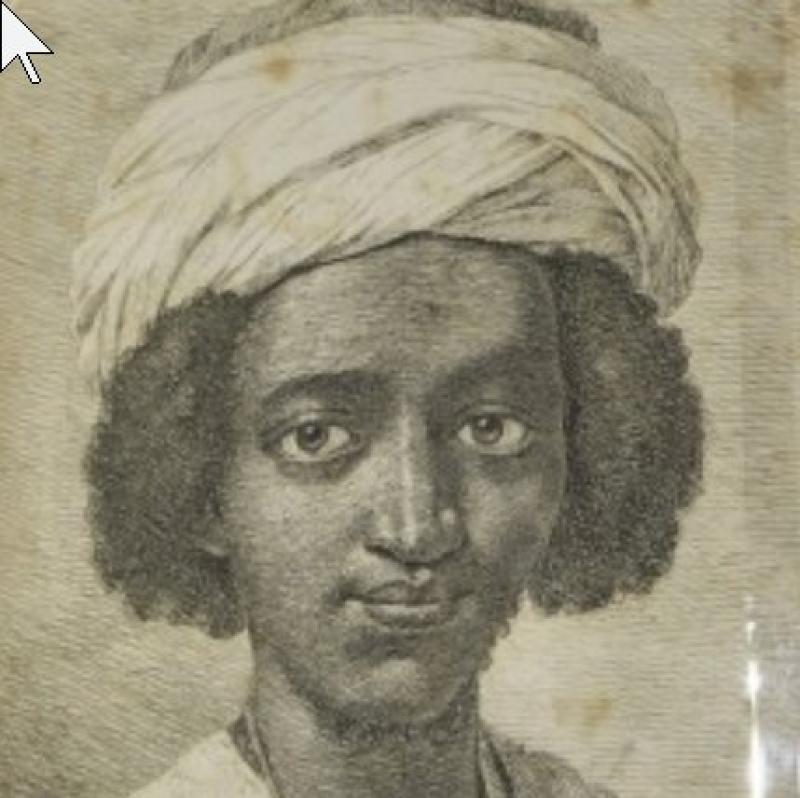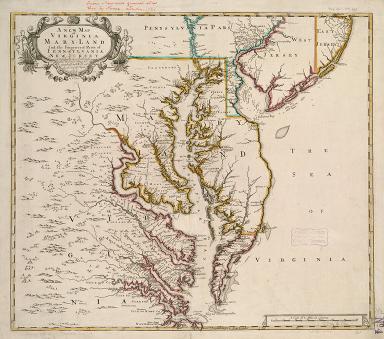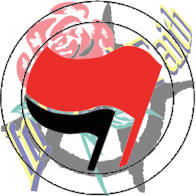Muslims of early America




The first words to pass between Europeans and Americans (one-sided and confusing as they must have been) were in the sacred language of Islam. Christopher Columbus had hoped to sail to Asia and had prepared to communicate at its great courts in one of the major languages of Eurasian commerce. So when Columbus’s interpreter, a Spanish Jew, spoke to the Taíno of Hispaniola, he did so in Arabic. Not just the language of Islam, but the religion itself likely arrived in America in 1492, more than 20 years before Martin Luther nailed his theses to the door, igniting the Protestant reformation.
Moors – African and Arab Muslims – had conquered much of the Iberian peninsula in 711, establishing a Muslim culture that lasted nearly eight centuries. By early 1492, the Spanish monarchs Ferdinand and Isabella completed the Reconquista , defeating the last of the Muslim kingdoms, Granada. By the end of the century, the Inquisition, which had begun a century earlier, had coerced between 300,000 and 800,000 Muslims (and probably at least 70,000 Jews) to convert to Christianity. Spanish Catholics often suspected these Moriscos or conversos of practising Islam (or Judaism) in secret, and the Inquisition pursued and persecuted them. Some, almost certainly, sailed in Columbus’s crew, carrying Islam in their hearts and minds.
Eight centuries of Muslim rule left a deep cultural legacy on Spain, one evident in clear and sometimes surprising ways during the Spanish conquest of the Americas. Bernal Díaz del Castillo, the chronicler of Hernán Cortés’s conquest of Meso-America, admired the costumes of native women dancers by writing ‘ muy bien vestidas a su manera y que parecían moriscas ’, or ‘very well-dressed in their own way, and seemed like Moorish women’. The Spanish routinely used ‘ mezquita ’ (Spanish for mosque) to refer to Native American religious sites. Travelling through Anahuac (today’s Texas and Mexico), Cortés reported that he saw more than 400 mosques.
Islam served as a kind of blueprint or algorithm for the Spanish in the New World. As they encountered people and things new to them, they turned to Islam to try to understand what they were seeing, what was happening. Even the name ‘California’ might have some Arabic lineage. The Spanish gave the name, in 1535, taking it from The Deeds of Esplandian (1510) , a romance novel popular with the conquistadores . The novel features a rich island – California – ruled by black Amazonians and their queen Calafia. The Deeds of Esplandian had been published in Seville, a city that had for centuries been part of the Umayyad caliphate (caliph, Calafia, California).
Across the Western hemisphere, whenever they arrived at new lands or encountered native peoples, Spanish conquistadores read the requerimiento , a stylised legal pronouncement. In essence, it announced a new state of society: offering Native Americans the chance to convert to Christianity and submit to Spanish rule, or else bear responsibility for all the ‘deaths and losses’ that would follow. A formal and public announcement of the intent to conquer, including an offer to the faithless of a chance to submit and become believers, is the first formal requirement of jihad. Following centuries of war with the Muslims, the Spanish had adopted this practice, Christianised it, called it the requerimiento , and took it to America. Iberian Christians might have thought Islam wrong, or even diabolical, but they also knew it well. If they thought it strange, it must be counted a very familiar strange.
B y 1503 , we know that Muslims themselves, from West Africa, were in the New World. In that year, Hispaniola’s royal governor wrote to Isabella requesting that she curtail their importation. They were, he wrote, ‘a source of scandal to the Indians’. They had, he wrote, repeatedly ‘fled their owners’. On Christmas morning 1522, in the New World’s first slave rebellion, 20 Hispaniola sugarmill slaves rose and began slaughtering Spaniards. The rebels, the governor noted, were mostly Wolof, a Senegambian people, who have been Muslim since the 11th century. Muslims were more likely than other enslaved Africans to be literate: an ability rarely looked upon with favour by plantation-owners. In the five decades following the 1522 slave rebellion on Hispaniola, Spain issued five decrees prohibiting the importation of Muslim slaves.
Muslims thus arrived in America more than a century before the Virginia Company founded the Jamestown colony in 1607. Muslims came to America more than a century before the Puritans founded the Massachusetts Bay Colony in 1630. Muslims were living in America not only before Protestants, but before Protestantism existed. After Catholicism, Islam was the second monotheistic religion in the Americas.
The popular misunderstanding, even among educated people, that Islam and Muslims are recent additions to America tells us important things about how American history has been written. In particular, it reveals how historians have justified and celebrated the emergence of the modern nation-state. One way to valorise the United States of America has been to minimise the heterogeneity and scale – the cosmopolitanism, diversity and mutual co-existence of peoples – in America during the first 300 years of European presence.
The writing of American history has also been dominated by Puritan institutions. It might no longer be quite true, as the historian (and Southerner) U B Phillips complained more than 100 years ago, that Boston had written the history of the US, and largely written it wrong. But when it comes to the history of religion in America, the consequences of the domination of the leading Puritan institutions in Boston (Harvard University) and New Haven (Yale University) remain formidable. This ‘Puritan effect’ on seeing and understanding religion in early America (and the origins of the US) brings real distortion: as though we were to turn the political history of 20th-century Europe over to the Trotskyites.
Think of history as the depth and breadth of human experience, as what actually happened. History makes the world, or a place and people, what it is, or what they are. In contrast, think of the past as those bits and pieces of history that a society selects in order to sanction itself, to affirm its forms of government, its institutions and dominant morals.
The forgetting of early America’s Muslims is, then, more than an arcane concern. The consequences bear directly on the matter of political belonging today. Nations are not mausoleums or reliquaries to conserve the dead or inanimate. They are organic in that, just as they are made, they must be consistently remade, or they atrophy and die. The virtual Anglo-Protestant monopoly over the history of religion in America has obscured the half-a-millenium presence of Muslims in America and has made it harder to see clear answers to important questions about who belongs, who is American, by what criteria, and who gets to decide.
W hat then should ‘America’ or ‘American’ mean? With its ‘vast, early America’ programme, the Omohundro Institute, the leading scholarly organisation of early American history, points to one possible answer. ‘Early America’ and ‘American’ are big and general terms, but not so much as to be nearly meaningless. Historically, they are best understood as the great collision, mixing and conquest of peoples and civilisations (and animals and microbes) of Europe and Africa with the peoples and societies of the Western hemisphere, from the Greater Caribbean to Canada, that began in 1492. From 1492 to at least about 1800, America, simply, is Greater America, or vast, early America.
Muslims were part of Greater America from the start, including those parts of it that would become the United States. In 1527, Mustafa Zemourri, an Arab Muslim from the Moroccan coast, arrived in Florida as a slave on a disastrous Spanish expedition led by Pánfilo de Nárvaez. Against all odds, Zemourri survived and made a life for himself, travelling from the coasts of the Gulf of Mexico through what is now the Southwestern US, as well as Meso-America. He struggled through servitude to native peoples before fashioning himself into a well-known and respected medicine man.
In 1542, Cabeza de Vaca, one of the four survivors of the Nárvaez expedition, published the first European book, later known as Adventures in the Unknown Interior of America , devoted to North America. De Vaca told of the disasters that befell the conquistadores , and of the eight years that the survivors spent wandering through North and Meso-America. De Vaca acknowledged that it was Zemourri who became the indispensable one: ‘It was,’ wrote de Vaca, ‘the negro who talked to them all the time.’ The ‘them’ were the Native Americans, and it was Zemourri’s facility with native languages that kept the men alive and even, after a time, allowed them a kind of flourishing.
Zemourri saw far more of the present-day US, its lands and peoples, than any of the country’s ‘founding fathers’ – even any several of them combined. Laila Lalami captures all of this and more in her excellent novel The Moor’s Account (2014), which follows Zemourri through his childhood in Morocco, slavery in Spain and, ultimately, to a mysterious end in the American Southwest. If there is such a thing as a best version of the American pioneer or frontier spirit, some resonating experience of adaptation and reinvention that can stamp itself on a nation and peoples, it is difficult to find one who represents it better than Zemourri.

A 1719 map of Maryland, Virginia, and Chesapeake Bay.
Courtesy Wikimedia
The first generations of Africans brought to North America were likely to work in the fields alongside and sleep under the same roof as their owners. They also, notes historian Ira Berlin in Many Thousands Gone (1998), tended to be eager converts to Christianity. They hoped conversion would help them secure social standing. West Africans brought during the late-17th and first half of the 18th century to work as slaves in Virginia, Maryland and the Carolinas came from different parts of Africa, or from the West Indies, than had these earlier ‘charter’ generations. They were more likely to be Muslims, and much less likely to be of mixed descent. Christian missionaries and planters in the 18th century complained that this ‘plantation generation’ of slaves showed little interest in Christianity. Missionaries and planters criticised what they saw as the slaves’ practice of ‘pagan rites’. Islam could, to an extent, persist on these plantations of American slave society.
Similarly, between 1719 and 1731, the French took advantage of civil war in West Africa to enslave thousands, bringing almost 6,000 enslaved Africans directly to Louisiana. Most of them came from Futa Toro, a region around the Senegal River straddling present-day Mauritania and Senegal. Islam had reached Futa Toro in the 11th century. Ever since, Futa has been known for its scholars, jihad armies and theocracies, including the Imamate of Futa Toro, a theocratic state that lasted from 1776 to 1861. Late-18th- and early 19th-century African conflicts in the Gold Coast (what is now Ghana) and Hausaland (mostly present-day Nigeria) also reverberated in the Americas. In the former, the Asante defeated a coalition of African Muslims. In the latter, the jihadists ultimately prevailed but in the process lost many compatriots to the slave trade and the West.

‘The Slave Qu’ran’ (XVIII), by Ayuba Suleiman Diallo.
Courtesy Dar El-Nimer Collection, Beirut
In such a fashion, the experience of enslavement and passage to America saw many Arabic names Anglicised; Quranic names rendered into something familiar from the King James Bible. Musa became Moses, Ibrahim became Abraham, Ayuba became Jacob or Job, Dawda became David, Suleyman became Solomon and so on. Toni Morrison drew on the history of Islamic naming practices in America in her novel Song of Solomon (1977). The title of the novel comes from a folk song that holds clues to the history of its protagonist, Milkman Dead, and his family. The fourth verse of the song begins: ‘Solomon and Ryna, Belali, Shalut / Yaruba, Medina, Muhammet too.’ These names came from African Muslims enslaved in Virginia, Maryland, Kentucky, the Carolinas and elsewhere in America. The song of Solomon, in other words, was also (and might have first been) the song of Suleyman.
Re-naming slaves (sometimes in derogatory or jesting ways) was an important tool of planter authority, and rarely neglected. Nonetheless, across North America, Arabic names remain part of the historical record. Louisiana court records of the 18th and 19th century show proceedings related to Almansor, Souman, Amadit, Fatima, Yacine, Moussa, Bakary, Mamary and others. Court records from 19th-century Georgia detail legal proceedings involving Selim, Bilali, Fatima, Ismael, Alik, Moussa and others. Newbell Puckett, a 20th-century sociologist, spent a lifetime collecting ethnographic material about Afro-American cultural life. In his Black Names in America: Origins and Usage , Puckett documented more than 150 common Arabic names among those of African descent in the South. Sometimes an individual had both – an Anglo or ‘slave name’ serving for official purposes, while the Arabic prevailed in practice.
It is difficult to know to what extent the persistence of Arabic names related to continued religious practice or identity, but it seems unlikely to be totally disconnected. A 1791 Georgia newspaper advertisement for a runaway slave, for example, read: ‘new Negro Fellow, called Jeffray … or IBRAHIM’. Given the careful control that slaveowners exerted over naming, there must have been many men called ‘Jeffray’ who were really Ibrahim, many women called ‘Masie’ who were actually Masooma, and so on.
Lorenzo Dow Turner, a mid-20th-century scholar of Gullah (a creole language spoken on the Sea Islands off America’s Southeastern coast) documented ‘about 150 names of Arabic origin’ relatively common on the Sea Islands alone. They include Akbar, Alli, Amina, Hamet and many others. On plantations in the early 19th-century Carolinas, Moustapha was a popular name. Arabic names do not necessarily make one a Muslim, at least not in the Maghreb or Levant, where Arabs are Christians and Jews too. But it was the spread of Islam that brought Arabic names to West Africa. So these African and Afro-American Aminas and Akbars, or at least their parents or grandparents, were almost surely Muslims.
O ut of fear , Spanish authorities had tried to ban Muslim slaves from their early American settlements. In the more established and secure slave society of 18th- and 19th-century Anglo-America, some planters preferred them. In both cases, the reasoning was the same: Muslims stood apart, possessed authority, and exerted influence. One publication – Practical Rules for the Management and Medical Treatment of Negro Slaves in the Sugar Colonies (1803), focused on the West Indies – advised that Muslims ‘are excellent for the care of cattle and horses, and for domestic service’ but ‘little qualified for the ruder labours of the field, to which they never ought to be applied’. The author noted that on the plantations: ‘Many of them converse in the Arabic language.’
An early 19th-century Georgia slaveowner who claimed to represent an enlightened approach to slavery advocated making ‘professors of the Mahommedan religion’ into ‘drivers, or influential negroes’ on plantations. He claimed that they would exhibit ‘integrity to their masters’. He and others cited instances of Muslim slaves siding with the Americans, against the British, in the War of 1812.
Some Muslim slaves in 19th-century America had themselves been slaveowners, teachers or military officers in Africa. Ibrahima abd al-Rahman was a colonel in the army of his father, Ibrahima Sori, an emir or governor in Futa Jallon, in what is now Guinea. In 1788, at age 26, al-Rahman was captured in war, purchased by British traders, and transported to America. Al-Rahman spent nearly 40 years picking cotton in Natchez, Mississippi. Thomas Foster, his owner, called him ‘Prince’.
In 1826, through an unlikely chain of events, al-Rahman came to the attention of the American Colonization Society (ACS). This society was organised for the goal of deporting people of African descent in the US ‘back’ to Africa. Comprised of many of the country’s leading philanthropists and some of its most powerful politicians, the ACS combined versions of both white nationalism and Christian universalism. For more than two years, the ACS pressured Foster, who finally agreed to free al-Rahman but refused to free his family. In an attempt to raise money to buy his family’s freedom, al-Rahman went to the free cities in the Northern US, where he busked at fundraising events and parades – wearing ‘Moorish’ costume and writing al-Fatiha, the opening of the Quran, on pieces of paper for donors (and leading them to believe it was the Lord’s Prayer).
Al-Rahman was a Muslim and he prayed as a Muslim. When he met with the leaders of the ACS, he told them he was a Muslim. Yet Thomas Gallaudet, a prominent Yale-educated evangelical and education activist, gave al-Rahman a Bible in Arabic and asked that they pray together. Holding out the prospect of transport to Africa and gainful employment, Arthur Tappan, America’s leading philanthropist, pressured al-Rahman to become a Christian missionary and to help extend the Tappan brothers’ lucrative commercial empire into Africa.
The African Repository and Colonial Journal , the ACS magazine, described how al-Rahman would ‘become the chief pioneer of civilisation to unenlightened Africa’. They saw him planting ‘the cross of the Redeemer upon the furthermost mountains of Kong!’ This, in capsule form, was the Puritan effect at work. First, al-Rahman’s religion and self-identification was denied. Second, powerful institutions specialising in writing, recordkeeping, publishing and education (essential technical skills in crafting history into the past) acted to misrepresent him.
The details of al-Rahman’s story might be unusual. But his experience as an American Muslim facing an Anglo-Protestant monopoly bent on manufacturing a ‘Christian’ country is not. Islam developed, in part, to exist above the great linguistic and cultural differences of Asia and Africa: al-Rahman spoke six languages. Anglo-American evangelical Protestantism is, by contrast, a younger, narrower religion. It took shape in the culturally circumscribed region of the North Atlantic and in a dynamic relationship with both capitalism and nationalism. It aims not at transcending heterogeneity but rather (as Gallaudet and Tappan were attempting with al-Rahman) to homogenise.
How many people shared al-Rahman’s basic experience? How many Muslims were there in America between, say, 1500 and 1900? How many in North America? Sylviane A Diouf is the great historian of the subject. In what is probably a conservative figuring, she writes in Servants of Allah (1998), ‘there were hundreds of thousands of Muslims in the Americas’ and ‘that may be all we can say about numbers and estimates.’ Of the 10 million or more enslaved Africans sent to the New World, more than 80 per cent went to the Caribbean or Brazil. Nonetheless, many more Muslims came to early America than did Britons arriving during the height of Puritan colonisation. The high point of Puritan settlement during the ‘Great Migration’, between 1620 and 1640, saw just 21,000 Britons come to North America. Perhaps 25 per cent of these came as servants whose Puritan sentiments cannot be presumed. By 1760, New England was home to – at most – 70,000 Congregationalists (the church of New England Puritans).
Despite these relatively small numbers, the Puritans succeeded in becoming the schoolmasters to a nation. Yet in some respects, New England is also the loser in the rise of the US. It reached its peak of economic and political influence in the 18th century. Despite its prominent role in US independence, it has never been the centre of economic or political power either in the British colonies in North America, nor in Greater America, nor even in the US.
Seen simply as one of many New World colonies, New England was in notable respects an outlier. It was demographically unique (for its settlement by families), religiously sectarian, politically anomalous and, from the perspective of Europe, economically secondary. Even the phrase ‘Puritan New England’ can be misleading. Fish, timber and maritime commerce – specifically, their trade with the West Indian plantations – not religion, made life in 17th- and 18th-century New England what it was. Puritans were neither beloved by nor necessarily representative of New Englanders. In the early 17th-century Massachusetts Bay Colony, for example, a listener once heckled a Puritan minister, interrupting his sermon with: ‘New England’s business is cod not God!’
Some of the same qualities that made the Puritans so unusual helped them excel at writing history. They were exceptionally adept in literacy, education, textual exegesis and institution-building. These skills enabled them, distinctly among Americans, to rise to the challenge of addressing what the sociologist Roger Friedland has called ‘the problem of collective representation’ in the modern world. Before modern nations, histories of peoples had been genealogies . A people were those who descended from an ancestor: Abraham or Aeneas, for example, and thus naturally related. The ideal of the modern nation presented a new problem. A nation is supposed to be one common people, who share fundamental, even inherent qualities – but not an ancestry, nor a king or queen.
A t the end of the 18th century, almost no one quite knew how to represent a common people. In North America, the Puritans came the closest. They thought and wrote of themselves not as a common people but a chosen people, a people not sharing descent from a lord but following the Lord. For rendering the history of a heterogeneous population into a national unity, it was by no means a perfect fit. But it would have to do.
The Puritan effect has excluded much, including the long and enduring presence of Muslims and Islam in America, as well as some of the integrity and poignancy of the Puritan experience on its own terms, distinct from its contributions to US national history. The domination of the Puritan institutions has given colonial New England an outsized role. Over two centuries, mores have changed a great deal, but great 19th-century historians such as Francis Parkman and Henry Adams share with their 20th- and 21st-century successors Perry Miller, Bernard Bailyn and Jill Lepore a commitment to finding America, and the national origins of the US, in 18th-century New England.
One of the most perverse feats of Puritan history-writing has been to claim the mantle of religious freedom as some Anglo-Protestant commitment. In fact, Puritans and evangelical Protestants in America have always conjured and persecuted religious enemies: Native Americans, Catholics, Jews, communists, LGBT people, Muslims and, sometimes especially, other Protestants. Neither John Winthrop, Cotton Mather nor any part of the Puritan squirearchy suffered real religious persecution. Possessing power, as Anglo-Protestants in America have, is not entirely compatible with the basis for some of the claims to moral authority of Christianity. Nor is it wholly consonant with the idea of America as a land of religious freedom, an asylum for the persecuted, as Tom Paine put it in 1776.
If there is any religious group who represents the best version of religious freedom in America, it is Muslims such as Zemourri and al-Rahman. They came to America under conditions of genuine oppression, and struggled for the recognition of their religion and the freedom to practise it. In contrast to Anglo-Protestants, Muslims in America have demurred the impulse to tyrannise others, including Native Americans.
The most persistent consequence of the Puritan effect has been a continuing commitment to producing a past focused on how the actions, usually courageous and principled, of Anglo-Protestants (almost always in New England and the Chesapeake) led to the United States of America, its government and its institutions. The truth is that the history of America is not primarily an Anglo-Protestant story, any more than the history of the West more broadly. It might not be a straightforward or self-evident matter what, exactly, constitutes ‘the West’. But the more global era in history inaugurated by the European colonisation of the Western hemisphere must be a significant part of it.
If the West means, in part, the Western hemisphere or North America, Muslims have been part of its societies from the very beginning. Conflicts over what the American nation is and who belongs to it are perennial. Answers remain open to a range of possibilities and are vitally important. Historically, Muslims are Americans, as originally American as Anglo-Protestants. In many ways, America’s early Muslims are exemplars of the best practices and ideals of American religion. Any statement or suggestion to the contrary, no matter how well-meaning, derives from either intended or inherited chauvinism.
Tags





Who is online
41 visitors
